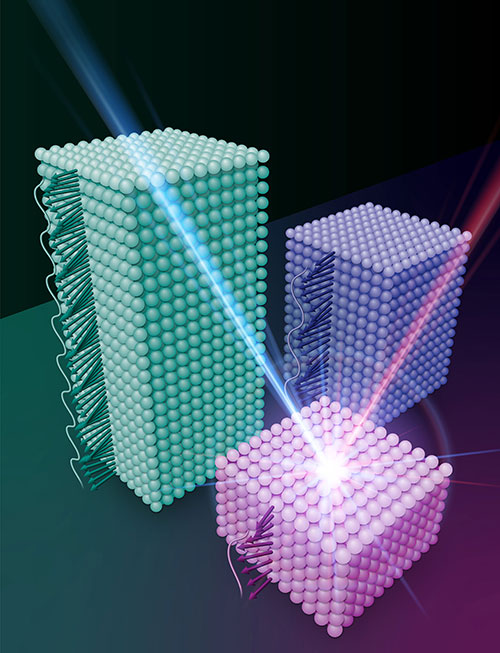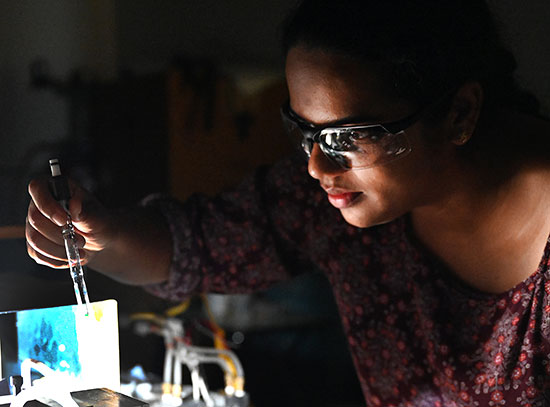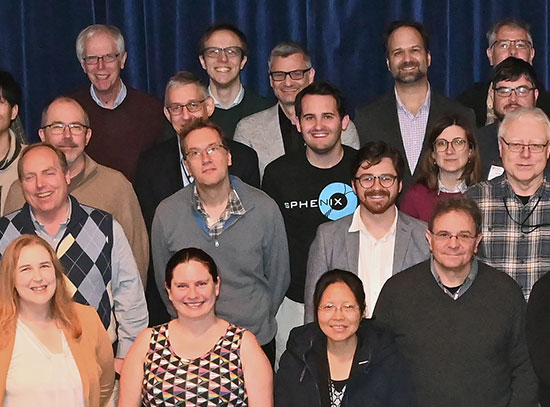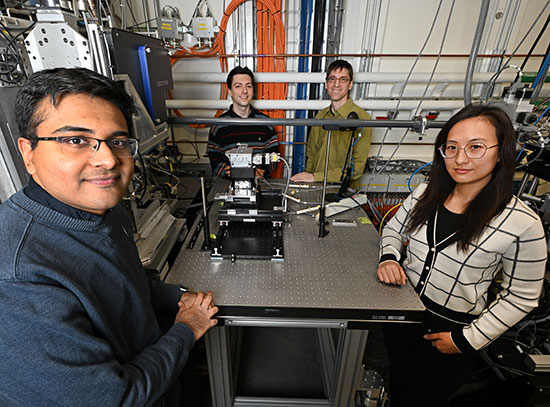Tuning Spin Excitations in Magnetic Films by Confinement
Scientists streamline the process for controlling spin dynamics
March 31, 2021
 enlarge
enlarge
An artist's interpretation of measuring the evolution of the spin dynamics as a function of thickness using resonant inelastic x-ray scattering. Image credit: Brookhaven National Laboratory
The Science
Scientists controlled spin dynamics in magnetic films by tuning their thickness.
The Impact
Spin excitations play an important role in novel electronic materials, but their behavior in thin films is less understood due to experimental limitations. This work revealed new insights about spin dynamics by using resonant inelastic x-ray scattering (RIXS).
Summary
Traditional electronics rely on a fundamental property of electrons—charge—to transmit information. But as electrical current flows throughout a device it dissipates heat, limiting how small devices can be designed. Mitigating the risk of overheating often results in sacrificing performance. To meet the demand for smaller and more advanced electronics, researchers are looking into an alternative approach based on a different fundamental property of electrons—spin. Understanding the general behavior of spin excitations in magnetic thin films is the key to unlocking the pathway to new electronics based on this property. While researchers have studied spin dynamics in bulk materials extensively, their studies of the same behavior in thin films were hampered by the lack of the right experimental tools.
In this work, a team of researchers used resonant inelastic x-ray scattering (RIXS) to investigate high-quality, ferromagnetic iron (Fe) films with various thickness, from 100 to 3 unit cells. Through their studies, the researchers discovered that in thick samples the magnetic behavior is consistent with the known information about it through other research techniques. However, they found that as the thickness is reduced, these ferromagnetic spin excitations change and become dependent on the thickness of the film. They found that the origin of this dependance was the change in out-of-plane spin excitations, which could explain them through the loss of Fe bonds at the surface using a Heisenberg model.
To make this discovery, the team used the Soft Inelastic X-ray Scattering (SIX) beamline at the National Synchrotron Light Source II (NSLS-II). NSLS-II is a U.S. Department of Energy (DOE) Office of Science User Facility located at DOE’s Brookhaven National Laboratory. The SIX beamline is part of NSLS-II’s advanced soft x-ray scattering and spectroscopy suite for materials research.
These findings, made possible by the SIX beamline, identified thickness as a knob for fine-tuning and controlling magnetic properties in films. This research could also be applied to other systems, opening a new pathway in the development of spin-based electronics.
Download the research summary slide
Related Links
Press Release: “Scientists Streamline Process for Controlling Spin Dynamics”
Contact
Jonathan Pelliciari
National Synchrotron Light Source II, Brookhaven National Laboratory
pelliciari@bnl.gov
Valentina Bisogni
National Synchrotron Light Source II, Brookhaven National Laboratory
bisogni@bnl.gov
Publications
J. Pelliciari, S. Lee, K. Gilmore, J. Li, Y. Gu, A. Barbour, I. Jarrige, C. H. Ahn, F. J. Walker, V. Bisogni, “Tuning spin excitations in magnetic films by confinement.” Nature Materials 20 (2), 188-193 (2021). DOI: 10.1038/s41563-020-00878-0
Funding
This work was supported by the US Department of Energy (DOE) Office of Science, Early Career Research Program. Work at Yale University was supported by the US DOE, Office of Science, Office of Basic Energy Sciences under award no. DE-SC0019211. K.G. was supported by the US DOE, Office of Science, Basic Energy Sciences as part of the Computational Materials Science Program. This research used beamline 2-ID (SIX) of NSLS-II, a US DOE Office of Science User Facility operated for the DOE Office of Science by Brookhaven National Laboratory under contract no. DE-SC0012704. Surface X-ray diffraction measurements were performed at beamline 33-ID-D of the Advanced Photon Source, a US DOE Office of Science User Facility operated for the DOE Office of Science by Argonne National Laboratory under contract no. DE-AC02-06CH11357.
2021-18940 | INT/EXT | Newsroom








